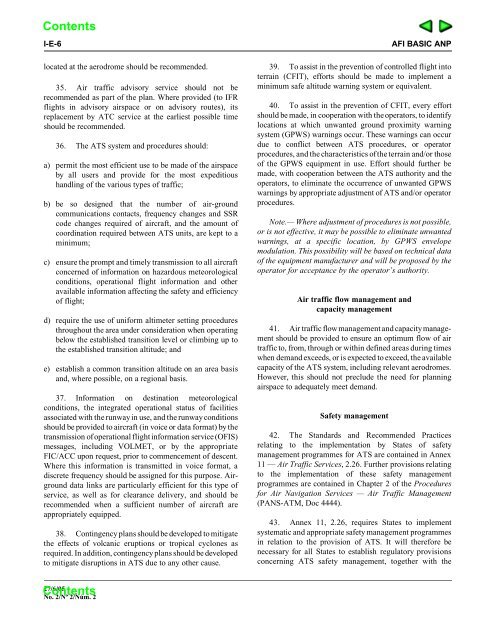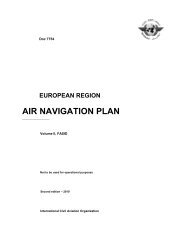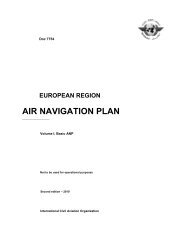introduction - ICAO Public Maps
introduction - ICAO Public Maps
introduction - ICAO Public Maps
Create successful ePaper yourself
Turn your PDF publications into a flip-book with our unique Google optimized e-Paper software.
I-E-6<br />
located at the aerodrome should be recommended.<br />
35. Air traffic advisory service should not be<br />
recommended as part of the plan. Where provided (to IFR<br />
flights in advisory airspace or on advisory routes), its<br />
replacement by ATC service at the earliest possible time<br />
should be recommended.<br />
36. The ATS system and procedures should:<br />
a) permit the most efficient use to be made of the airspace<br />
by all users and provide for the most expeditious<br />
handling of the various types of traffic;<br />
b) be so designed that the number of air-ground<br />
communications contacts, frequency changes and SSR<br />
code changes required of aircraft, and the amount of<br />
coordination required between ATS units, are kept to a<br />
minimum;<br />
c) ensure the prompt and timely transmission to all aircraft<br />
concerned of information on hazardous meteorological<br />
conditions, operational flight information and other<br />
available information affecting the safety and efficiency<br />
of flight;<br />
d) require the use of uniform altimeter setting procedures<br />
throughout the area under consideration when operating<br />
below the established transition level or climbing up to<br />
the established transition altitude; and<br />
e) establish a common transition altitude on an area basis<br />
and, where possible, on a regional basis.<br />
37. Information on destination meteorological<br />
conditions, the integrated operational status of facilities<br />
associated with the runway in use, and the runway conditions<br />
should be provided to aircraft (in voice or data format) by the<br />
transmission of operational flight information service (OFIS)<br />
messages, including VOLMET, or by the appropriate<br />
FIC/ACC upon request, prior to commencement of descent.<br />
Where this information is transmitted in voice format, a<br />
discrete frequency should be assigned for this purpose. Airground<br />
data links are particularly efficient for this type of<br />
service, as well as for clearance delivery, and should be<br />
recommended when a sufficient number of aircraft are<br />
appropriately equipped.<br />
38. Contingency plans should be developed to mitigate<br />
the effects of volcanic eruptions or tropical cyclones as<br />
required. In addition, contingency plans should be developed<br />
to mitigate disruptions in ATS due to any other cause.<br />
AFI BASIC ANP<br />
39. To assist in the prevention of controlled flight into<br />
terrain (CFIT), efforts should be made to implement a<br />
minimum safe altitude warning system or equivalent.<br />
40. To assist in the prevention of CFIT, every effort<br />
should be made, in cooperation with the operators, to identify<br />
locations at which unwanted ground proximity warning<br />
system (GPWS) warnings occur. These warnings can occur<br />
due to conflict between ATS procedures, or operator<br />
procedures, and the characteristics of the terrain and/or those<br />
of the GPWS equipment in use. Effort should further be<br />
made, with cooperation between the ATS authority and the<br />
operators, to eliminate the occurrence of unwanted GPWS<br />
warnings by appropriate adjustment of ATS and/or operator<br />
procedures.<br />
Note.— Where adjustment of procedures is not possible,<br />
or is not effective, it may be possible to eliminate unwanted<br />
warnings, at a specific location, by GPWS envelope<br />
modulation. This possibility will be based on technical data<br />
of the equipment manufacturer and will be proposed by the<br />
operator for acceptance by the operator’s authority.<br />
Air traffic flow management and<br />
capacity management<br />
41. Air traffic flow management and capacity management<br />
should be provided to ensure an optimum flow of air<br />
traffic to, from, through or within defined areas during times<br />
when demand exceeds, or is expected to exceed, the available<br />
capacity of the ATS system, including relevant aerodromes.<br />
However, this should not preclude the need for planning<br />
airspace to adequately meet demand.<br />
Safety management<br />
42. The Standards and Recommended Practices<br />
relating to the implementation by States of safety<br />
management programmes for ATS are contained in Annex<br />
11 — Air Traffic Services, 2.26. Further provisions relating<br />
to the implementation of these safety management<br />
programmes are contained in Chapter 2 of the Procedures<br />
for Air Navigation Services — Air Traffic Management<br />
(PANS-ATM, Doc 4444).<br />
43. Annex 11, 2.26, requires States to implement<br />
systematic and appropriate safety management programmes<br />
in relation to the provision of ATS. It will therefore be<br />
necessary for all States to establish regulatory provisions<br />
concerning ATS safety management, together with the<br />
27/6/05<br />
No. 2/Nº 2/Núm. 2














